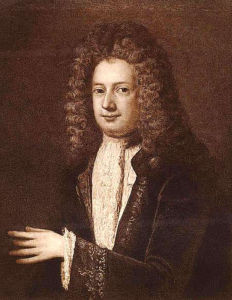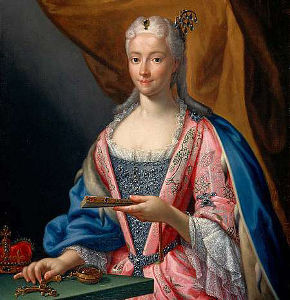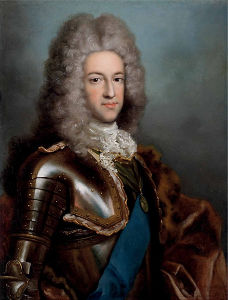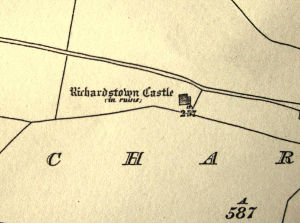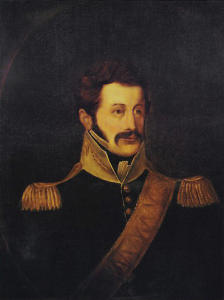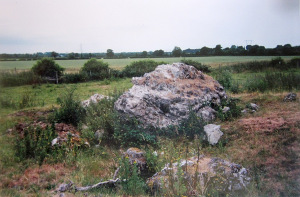Charles Wogan (1685–1752)
The Amazing Career of a ‘Wild Geese’ Patriot
Published in The Bridge 2016, by St Mochua Historical Society
Sir Charles Wogan also known as Chevalier Wogan was one of the most famous individuals from history to have been born in the Clane area. He is regarded among the leading historical figures of the ‘Wild Geese’. This term is used in Irish history to refer to Irish soldiers who left to serve as mercenaries in continental European armies between the 16th and 18th centuries. Wogan had an illustrious career during his life and on different occasions was active as a rebel leader; diplomat; agent; army general; administrator and writer. But it was as an adventurer that he is most widely known due to his rescue of Princess Clementina in 1719 which gained him international fame.
Wogan who belonged to one of the leading Norman Irish families in county Kildare was born in 1685 in Richardstown Castle just outside Clane.1 The Richardstown Wogans were a junior branch of the Rathcoffey Wogans and Charles was the eldest son of Patrick Wogan and his first wife Mary Dempsey.2 The Castle at Richardstown was by all accounts a substantial Tower House. Surviving descriptions indicated that it as a square building extending to about sixty feet in height.3
Very little is known of Wogan’s early life in the Clane area. It is known that Patrick Wogan’s children including his eldest son Charles were baptized in the Parish Church in Clane, now the Abbey Community Centre. Due to the fact that is was a Protestant Church at the time and as the Wogans were Catholic it is thought the baptisms took place in a small wing of the Church or a Chantry Chapel off the main Church, which accommodated the Wogan burial vault. Part of the wall of this building which included the Wogan memorials still survives at the rear of the Abbey Community Centre.4 The Wogan family were strong Jacobites and it is likely that Charles and his cousin Nicholas Wogan (c.1682–1757) from nearby Rathcoffey cooperated in Jacobite political activity.5
Jacobite Rebellion of 1715
Charles Wogan left Ireland for England in 1712 and his involvement in Jacobite activity escalated. When the Jacobite rebellion occurred in England in 1715 both Charles and Nicholas served as leading officers in the Jacobite army.6 The rebels aimed to restore the Catholic Stuarts to the throne of England and Ireland and install James Stuart son of King James II as King. During the rebellion Charles served as aide-de-camp to General Thomas Forster in the north of England, and saw action at Preston. The rebellion collapsed, and Charles Wogan was imprisoned. In May 1716 several Jacobites including Wogan were to go on trial for high treason in London. However, at midnight on the eve of his trial Wogan took part in a successful escape from Newgate. He was one of seven Jacobite prisoners that escaped having disarmed the guards who were armed with bayonets. A reward of £500 was offered for the capture of the Jacobites. Wogan went into hiding in London and on one occasion the house where he had taken refuge was raided. He narrowly escaped and for a whole day afterwards lay on the roof of a house while the military searched for the prisoners. In the darkness of night he made his way to the coast and eventually escaped to France.7
Agent for James Stuart
At this point he entered the service of James Stuart who is known throughout history as ‘The Old Pretender’. He was recognized by many of the Catholic nations of Europe as the legitimate King of England but was still a bachelor. The Jacobites in the aftermath of the failure of the Rebellion of 1715 sought a marriage for James that would be advantageous to the Stuart cause. As a Jacobite agent, Wogan was given the task of finding a bride for the Prince. He traversed Europe in search of a suitable bride and was initially unsuccessful; however, in 1718 he selected 16 years old Princess Clementina Sobieski a Polish Princess. Wogan found her credentials satisfactory. She was the granddaughter of King John Sobieski of Poland who in the previous century was regarded as the saviour of Europe when he defeated the Turks at Vienna in 1683. Her qualifications were impeccable, she was a Catholic and related to several of the royal families of Europe. Furthermore, her godfather was Pope Clement XI. More importantly, she provided a substantial dowry which would be useful for cash starved exiled prince who was living on an income provided by the Pope. British agents soon became aware of the match and the Emperor of Austria was persuaded by the British authorities to prevent the union. As the Princess accompanied by her mother set out for her wedding in Rome they had to cross Austrian territory and were detained at Innsbruck by the Emperor Charles VI. He ordered that they be confined under guard in a secure house in the city. Charles VI under pressure from the British and despite the fact that the Princess was his cousin and her mother was his aunt was determined to prevent the marriage.
This event was a sensation at the time and regarded as a low point in international diplomacy. It was against the law of nations, and it was contrary to the practice and constitutions of the Holy Roman Empire which was the official name of the Austrian Empire. It looked as if the detention would continue indefinitely and the marriage would have to be abandoned.
Wogan Rescues the Princess
Wogan, however, had a rescue plan but had to obtain permission from a number of parties including James Stuart and John Sobieski, Clementina’s father. This he obtained, although not without difficulty. His journeys through Germany at this time were watched by British spies but he managed to give them the slip at Prague.8 For his mission he recruited a small number of assistants that included three fellow Wild Geese officers, Richard Gaydon originally from Irishtown, Straffan who was his cousin, together with John Misset and Luke O’Toole who were also kinsmen of Wogan. Also joining the rescue party was John Misset’s wife who was four months pregnant and she was accompanied by her maid Jeanetton. Completing the group was James Stuart’s confidential Italian valet Michael Vezzozi.9
A letter with details of the escape plan was smuggled into the Princess and she agreed to co-operate and carry out Wogan’s instructions. Wogan obtained a false passport in the name of Count de Cernes from the Pope for the mission. Richard Gaydon and Mrs Misset passed themselves off as the Count and Countess de Cernes, Jeanetton, Mrs Misset’s maid as the Countess’s maid and Wogan as a brother of the Countess. On horseback alongside the carriage, Misset, O’Toole and Vezzozi, passed themselves off as the Counts armed guards.
On the evening of 29th April 1718 the carriage of the rescue party arrived in Innsbruck and booked into an Inn in the town. Konska, a male servant belonging to the Princess was to bring Jeanetton into the building where Clementina was held. Clementina would take the place of Jeanetton when leaving the building. However, Jeanetton was not told the full story and suspecting that she was expected to take the place of someone of importance refused to cooperate. But following a lot of persuasion particularly from Mrs Misset she finally consented to go ahead with the plan. Although there was a snow storm on the night chosen for the rescue the plan went ahead, Jeanetton gained entrance into the closely guarded building changed clothes with the princess and took her place. Wogan met the princess at the gate of the building and brought her to the Inn where after a change of clothes the group set out on their journey. However, progress over mountain passes to Italy was slow, particularly during a snow storm and there were difficulties in obtaining changes of horses for the carriage. In the days before the escape a German Count, had visited Clementina in an unsuccessful attempt to seek her hand in marriage. This Count’s carriage had set off from Innsbruck on the same route just hours before the rescue party and availed of all available fresh horses at the various staging posts. This caused considerable difficulties in obtaining a change of horses for the carriage carrying the princess.
The morning after the escape General Heister who was in charge of the security at the building where the princess was confined became suspicious. Part of the plan drawn up by Wogan was for Clementina to fake an illness and retire to her bed early on the night of the proposed rescue.10 The General, however, forced his way into the princess’s bedroom, severely wounding Konska who resisted, and discovered the escape. Immediately, he sent couriers along all the likely escape routes to alert the authorities. Wogan, however, had anticipated this and had left Misset and O’Toole at a staging post on the route they had taken to intercept any courier sent from the authorities at Innsbruck. When the messenger arrived at the staging post he was unable to obtain a change of horse and had to rest for the night. At this point the group with the princess had only left the staging post only two hours previous. The two Irishmen befriended him and generously plied him with brandy. Inevitably he succumbed to a high level of intoxication, whereby the Irish men relieved him of his dispatch. With one danger averted the carriage carrying the princess encountered several more difficulties. The axle of the carriage broke 6 miles from Italian territory and Wogan, not waiting for time for the repairs to be carried out, ordered the group to proceed on foot to Ala the last Austrian town before the border with Italy. Here all Wogan could do was to obtain a cart seating two people which accommodated the Princess and Mrs Misset and with the men Wogan and Gaydon on foot they set out on the last leg of the journey of five miles to the Italian border and safety. The journey had taken from 2 o’clock on Friday morning until the early hours of Sunday morning 30th April 1719. They covered 150 miles on some of the worst and steepest roads of Europe.11
Safely in Italy, they headed for Bologna and on the 9th of May, James Stuart and Clementina were married. The marriage ceremony was performed by proxy with Wogan representing James Stuart who was in Spain at the time. It was not unusual for a proxy wedding to be performed at the time. The Princess’s party now set out for Rome where she was to officially marry James Stuart. On the journey an amusing incident occurred. Wogan who continued to be in charge of the princess’ entourage invited her to a banquet which he had ordered on the route at a place he jokingly named ‘Radicofani’. He indicated the name came from ‘the castle of his forefathers’ in Ireland which was named Rathcoffey.12
The rescue astonished Europe. An unbelievable task had been accomplished by a small number of adventurers led by Wogan. Overnight it propelled Wogan to celebrity status, he became one regarded as a Knight in shining amour that rescued a young beautiful princess against all odds and delivered her to her betrothed. Wogan was now the most talked about man in all the Courts in Europe and was for a time regarded as the most famous man in Europe. He received numerous honors. In recognition Pope Clement XI, bestowed on each of the four Irishmen the title of Senator of Rome and had a special coin minted in commemoration of the rescue. James Stuart conferred knighthoods on all four Irishmen, making Wogan a Knight-Baronet. Unfortunately in the 18th century women were not directly rewarded, however, Mrs Misset’s role in the affair was recognized and her father was advanced to the rank of colonel, in recognition of the distinguished services rendered by his daughter.13
The epic unfortunately did not have a happy ending and the couple did not live happily after. Two sons, Charles, better known as Bonnie Prince Charlie and Henry were born to the couple, but Clementine left her husband shortly after the birth of their second son. Plagued with illness she died at the relatively young age of 32. Today she rests in St. Peters Basilica in Rome where a monument marks the spot.14
Wogan’s Career in Spain
Wogan on the other hand made the most of his newly gained fame. Some months after the rescue he entered the service of King Philip V of Spain and was commissioned a Colonel in the Spanish army. His career as a military officer in Spain also brought success, in 1723 he was sent on an expedition with a force of 1,300 men to rescue the fortress of Santa Cruz. This fortress was besieged by an army of 20,000 Moors and Wogan despite losing half his men successfully relieved the siege. For this victory he was promoted to the rank of brigadier-general.15 In 1744, after 25 years of military service in Spain he was appointed governor of La Mancha, a province in central Spain. Six years later in 1750 he was appointed to the more important governorship of Barcelona.16
Jacobite Rebellion 1745
While in Spain, Wogan continued to assist the Jacobite cause. In July 1745 he received a message from Bonnie Prince Charley that a Jacobite rebellion was about to commence in Scotland. The message from the Prince was for Wogan to take command of such men as might be enlisted for an expedition from Spain. Spain agreed to send money, arms and four frigates to assist the Jacobite rebellion in Scotland. Unfortunately for Wogan, he contacted a fever and was unable to sail with any of the Spanish frigates as he had planned. Despite his inability to leave for Scotland, Wogan indulged in diplomacy in support of the rebellion and even once again, match-making. Should the rebellion succeed he had made advanced progress in arranging a marriage between Prince Charlie and the King of Spain’s youngest daughter. Wogans attempt to get the Spanish Irish Brigade dispatched to Scotland did not meet with any urgency by the Spanish administration. By early April of the following year he had joined a number of other Irish officers in Paris who were seeking a means to join Prince Charlie in Scotland. However, on the 16th of April the Prince Charlie and his army were defeated at Culloden in the Scottish Highlands and with it ended the Jacobite cause. In the late summer a bitterly disappointed Wogan returned to his Spanish duties.17
Connection with Dean Swift
Wogan, throughout his career enjoyed writing which he indulged in during his leisure time and much of his work has been published. In 1722 he published an account of the rescue at Innsbruck entitled Female Fortitude. Between 1732 and 1735 he was in contact with Dean Swift and sent him some of his writings including unpublished English and Latin verses. Wogan was impressed by Dean Swift’s active opposition to the Government and regarded him as one of the finest writers of his time. He asked Swift to correct some of his works and sought advice in getting them published. With his correspondence, he also sent Swift caskets of Spanish wine. Swift wrote back complementing him on the high standard of his writings but was unable to assist in getting them published in Ireland and suggested he approach publishers in London. Swift who described Wogan as a man of genius and of honor, discovered that he had a brother and near relatives in Ireland. Although, Swift expressed a desire to meet them when they came to Dublin, this is not thought to have happened as the Wogans’ who were stanch Jacobite Catholics, kept a low profile during the penal period.18
James Wogan
Although Wogan was successful in most of his endeavors in Europe, the same level of success eluded him in Ireland. In the early 1730s his brother James, who had been ordained a Catholic priest, had become a leading cleric in the Irish College at St. Germain just outside Paris. When then archbishopric of Dublin became vacant in 1734, Charles lobbied unsuccessfully to have him appointed to the position. James who was born circa 1701 in Richardstown was well qualified as he had been appointed Professor of divinity in the Irish college.19
Death
Charles Wogan died in Barcelona in 1754. He was survived by his wife Anne O’Driscoll, whom he had married in 1725 and his step-daughters. His son James who was born in the late 1720s predeceased him. The title Baron de Wogan granted to him in 1719 passed to his half-brother Francis who is recorded as having been baptized in Clane Church in 1720.20
From Richardstown
Although Wogan is regarded in history as from Rathcoffey Castle, it is highly unlikely he ever lived there. His father Patrick resided in Richardstown Castle which was his residence throughout his lifetime. The Wogans of Richardstown were an emerging junior branch of the Rathcoffey Wogans and despite living in Richardstown were almost always referred to as from Rathcoffey. When Charles Wogan was born in 1685 he was second in line of inheritance to the Rathcoffey estates and he regarded Richardstown as part of the estate.21 Throughout his life he always referred to having been from Rathcoffey.22
Painstown Aylmers
The family connection with the Clane area seems to have ended by the mid 18th century. Wogan’s last sibling to live in the area was his sister Catherine who was married to Patrick Aylmer of Painstown. Two of their sons, Gerald and Robert served as senior military officers in the army of Spain.23 It is likely that Wogan assisted them in their advancement as military officers. The eldest son of the Aylmers was named Charles after his illustrious uncle. He was the father of William Aylmer the local rebel leader in 1798. For many generations one of the prize possessions of the Painstown Aylmers was a painting of Sir Charles Wogan which is now in the National Gallery of Scotland.24
1954 Commemeration
His exploits were remembered in 1954 when the bi-centenary of his death was commemorated by a committee headed by Fr. John Doyle parish priest of Clane. On that occasion tours and lectures were held at several Wogan sites in the Clane area including Richardstown and Rathcoffey.25
Film
Several films featuring Princess Clementina’s escape have been made on the continent, mainly in the German language. Unfortunately, as yet no film or documentary has been undertaken in the English language, although the 1954 Hollywood film ‘Iron Glove’ was loosely based on the Innsbruck epic. In the film the leading part of Charles Wogan was played by Robert Stack.26
Conclusion
The rescue of Clementina is regarded as an important historical event in many countries in central Europe particularly in Austria and features prominently in the history books. Several studies relating to the epic have been made and continue to be undertaken with Wogan even being described as an 18th century James Bond. Yet this famous adventurer is virtually forgotten in his native Clane apart from a brief inscription on a plaque on the wall of the Abbey Community centre. The only other physical connection to him in his native area is a small clump of stones at the top of Richardstown cul-de-sac which is all that remains of his birth place, Richardstown Castle.
Footnotes
- Hugh A. Law, Sir Charles Wogan in The Journal of the Royal Society of Antiquaries of Ireland, Seventh Series, Vol. 7, No. 2 (1937), pp. 253–264.
- Matthew Devitt, Rathcoffey in Journal of the Kildare Archaeological Journal, Vol. III, p.86, pedigree B; Patrick Wogan married on three occasions, his second wife was Anne Wolverston and his third Thomasine Chamberlain.
- Ordnance Survey letters Mainham parish, p. 26.
- A History of Christianity in Clane & Rathcoffey (Naas, 2011), p. 78.
- According to Hugh A. Law, Nicholas Wogan was born c.1682. p. 258.
- According to Hugh A. Law, Charles served as a Captain and Nicholas served as Colonel.
- Matthew Devitt, Rathcoffey, in the Kildare Archaeological Journal, Vol. 3, p. 83.
- Gerard Morris, Of a Princess and Four Irishmen, in The Capuchin Annual 1977, p. 57.
- According to Wogan in his narrative, Charles Wogan, Female Fortitude, exemplified in an impartial narrative of the seizure, escape and marriage of Princess Clementina Sobieski (1722), p. 15, Vezzozi was referred to as ‘Mitchell’ who was instrumental in engineering the escape of Lord Nithsdale from the Tower of London in 1716.
- According to Tony Canavan, Making a Hole in the Moon: the rescue of Princess Clementina, in History Ireland (Winter 1993), p. 19, Konska was killed in the incident; According to M. J. Flood,
The life of Chevalier Charles Wogan; An Irish Soldier of Fortune, (Dublin, 1922) p. 108, Konska was wounded. - For full details of the escape see, Gerard Morris, Of a Princess and Four Irishmen, pp 51–69; Canavan, Making a Hole in the Moon, pp 19–22.
- Flood, Chevalier Charles Wogan, p. 99.
- Flood, Chevalier Charles Wogan, p. 111.
- Hugh Douglas, ‘Clementina (1702–1725)’, in the Oxford Dictionary of National Biography (2004).
- Flood, Chevalier Charles Wogan, pp 113–14.
- Hugh A. Law, Sir Charles Wogan, in JRSAI (1937), pp 260; 264.
- Details of Wogan’s connection to the Rebellion of Forty-Five are given in, Law, Sir Charles Wogan, pp 261–63.
- Flood, Chevalier Charles Wogan, p. 127.
- Christanity in Clane & Rathcoffey, pp 78, 79.
- Christianity in Clane & Rathcoffey, p. 78. Francis was the son of Patrick Wogan and his third wife Thomasine Chamberlain.
- Law, Sir Charles Wogan, p. 256.
- The Rathcoffey Wogan family are extinct, however, the line is carried on by Wogan-Brown family. John Wogan Browne, Australia is head of this family.
- General Sir Fenton Aylmer, The Aylmers of Ireland, (London, 1931), p. 213.
- Richard John Aylmer, ‘William Aylmer 1778–1820 and the Aylmers of Painstown’ in Fugitive Warfare, (Clane, 1998), p. 35; For many generations one of the prize possessions of the Painstown Aylmers was a painting of Sir Charles Wogan. It was sold in 1891 and is now in the National Gallery of Scotland.
- Leinster Leader 1954; Christanity in Clane & Rathcoffey, p.201.
- For details of the film see Robert Stack, Mark Evans, Straight Shooting (New York, 1980).

